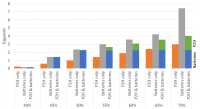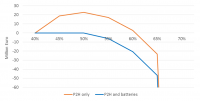Wolf-Peter Schill, DIW Berlin
Overview
Spurred by technology development and regulatory incentives, self-consumption of distributed renewable electricity generation has gained relevance in many power markets. Building on the concept of “prosumers” (producers and consumers), the term “prosumage” has emerged, which additionally includes decentral energy storage (producers, consumers and storage). We define prosumagers as grid-connected electricity consumers who deploy both PV generators and energy storage installations to produce their own electricity at times, draw electricity from the grid at other times, and feed electricity to the grid at yet other times. In earlier work, we discussed arguments in favor of and against increasing prosumage and presented a quantitative model analysis of prosumage’s system effects, focusing on batteries (Schill et al. 2017). We now explore the effects of additional energy storage and/or conversion options related to electric heating and electric vehicles (cp. Green and Staffell 2017). Compared to battery prosumage, these options trigger different system effects, as they increase both electricity demand and flexibility supply.
Methods
We use an extended version of the open-source electricity system model DIETER (www.diw.de/dieter, Schill et al. 2017). The model’s objective is to minimize overall system costs over a full year in hourly resolution. Input data is based on 2035 projections for Germany, including hourly demand and availability factors of variable renewables. A certain share of overall solar PV and a corresponding share of the electric load are attributed to the prosumage segment. In each hour, there are different options for using prosumagers’ solar PV generation: serve domestic consumption directly, sell it to the market, curtailment, battery storage loading, electric heating, or charging electric vehicles. The model setup does not explicitly consider prosumagers’ incentives (like, for example, Borenstein 2017), but approximates these by varying exogenous self-generation constraints.
Preliminary results
Notwithstanding potentially positive socio-economic aspects of solar prosumage (cp. Schill et al. 2017), total system costs rise with increasing self-consumption requirements, as redundant infrastructure is built. Yet the cost increase is lower for higher degrees of prosumagers’ market interaction, which in reality would require appropriate communication infrastructure, aggregators, and supportive regulatory frameworks. Further, welfare gains with respect to decarbonization of heating and mobility markets have to be considered. Focusing on electric heating, preliminary results indicate that storage heaters allow achieving higher self-consumption rates with lower capacity requirements and at lower costs when compared to battery prosumage (Figure 1). This is driven by lower energy storage capacity costs. Looking at system costs, there is a trade-off between the additional electricity demand and the storage cost advantages of electric heaters. Compared to battery prosumage, the demand effect dominates up to around 60% self-consumption, while the investment cost effect dominates for higher shares (Figure 2). At the time of writing, the parameterization of electric vehicles was still ongoing, but respective results will be available soon.



Comments for BIEE Members only.
Sign in or become a member today.